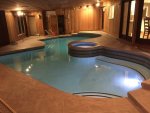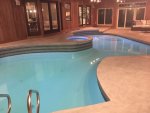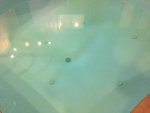Hey All,
I'm helping another friend in town (yes, this seems to be a theme ) get their newly refurbished indoor pool balanced. This is a plaster pool, that is coated with epoxy, so I'm assuming it's epoxy paint, and should be managed/cared for as a plaster pool.
) get their newly refurbished indoor pool balanced. This is a plaster pool, that is coated with epoxy, so I'm assuming it's epoxy paint, and should be managed/cared for as a plaster pool.
Anyway, I went over because he is concerned it was starting to turn green. My initial reaction when I saw it was that it did not look like algae, but rather just the depth and color of the water given the lighting and such. Another friend of ours (the one I helped with their lagoon style pool last year) suggested that it looked like the "color" of bleach, and maybe was way too high in chlorine. We weren't' sure, but the water was crystal clear, you could spot a dime in the deep end, but just a slight greenish/blue tint.
Anyway, I took a full set of test results, and was shocked to find the salt level and pH off the charts. And some things nonexistent from what I can tell.
The pool is likely around 22-25,000 gallons, which I'll confirm tonight after adding some bleach, and retesting to see the impact of the added chlorine (to calculate gallons). It has a Pentair itellichlor SWG. Separate spa that can mix with pool water. Propane/electric heater as well. Cleaning the SWG cell is going to be a real pain given how the pool builder installed it. It is directly behind and at the back of the heater. You cannot reach it easily at all, so that will be a PITA to check the plates for buildup. This pool will run all year long, so it will be more than a once/twice a season thing as is more common here in New England.
Anyway, this pool was completed (the remodel) and has had water in it for 2 weeks already. The builder didn't really do all that much to help the owner understand how to manage the water, so it's time for us to take over.
Here's the results:
Cl: 5
CC: 0.5
CYA: 0
TA: 0 (I assume, as the test went RED immediately upon adding the second reagent, never needed to add a single drop of the third reagent to get it to turn red)
pH: <6.6 (I think it's possibly lower and just off the scale low as we added sodium carbonate that we had, 4 pounds, and that showed zero change - working on this one right sway)
CH: 60
Salt: 8000ppm (average of 3 tests)
The plan of attack is this:
1. Get PH right, asap. The owner adding, as I instructed him to, Washing Soda last night. I will retest tonight.
2. Determine actual pool volume (tonight, with a bleach test)
3. Bring up TA to proper levels.
4. Bring up CH a bit (especially given it's a plaster pool behind the epoxy)
5. Run an OCLT to determine if there really is any algae in the water.
6. Dump about 25% of that salty water and refill with clean water.
Since it's an indoor pool, very little splash out will occur so the salt will take forever to disappear on it's own from use.
First question is how high salt levels like this might skew other tests. From what I can tell, they will not, but certainly that much salt is corrosive and not needed. The SWG is even flashing "HIGH SALT".
And second, please advise on CYA needs on an indoor pool where the impact of sun isn't there, and buffering of chlorine likely not critical.
Thanks all!
I'm helping another friend in town (yes, this seems to be a theme
Anyway, I went over because he is concerned it was starting to turn green. My initial reaction when I saw it was that it did not look like algae, but rather just the depth and color of the water given the lighting and such. Another friend of ours (the one I helped with their lagoon style pool last year) suggested that it looked like the "color" of bleach, and maybe was way too high in chlorine. We weren't' sure, but the water was crystal clear, you could spot a dime in the deep end, but just a slight greenish/blue tint.
Anyway, I took a full set of test results, and was shocked to find the salt level and pH off the charts. And some things nonexistent from what I can tell.
The pool is likely around 22-25,000 gallons, which I'll confirm tonight after adding some bleach, and retesting to see the impact of the added chlorine (to calculate gallons). It has a Pentair itellichlor SWG. Separate spa that can mix with pool water. Propane/electric heater as well. Cleaning the SWG cell is going to be a real pain given how the pool builder installed it. It is directly behind and at the back of the heater. You cannot reach it easily at all, so that will be a PITA to check the plates for buildup. This pool will run all year long, so it will be more than a once/twice a season thing as is more common here in New England.
Anyway, this pool was completed (the remodel) and has had water in it for 2 weeks already. The builder didn't really do all that much to help the owner understand how to manage the water, so it's time for us to take over.
Here's the results:
Cl: 5
CC: 0.5
CYA: 0
TA: 0 (I assume, as the test went RED immediately upon adding the second reagent, never needed to add a single drop of the third reagent to get it to turn red)
pH: <6.6 (I think it's possibly lower and just off the scale low as we added sodium carbonate that we had, 4 pounds, and that showed zero change - working on this one right sway)
CH: 60
Salt: 8000ppm (average of 3 tests)
The plan of attack is this:
1. Get PH right, asap. The owner adding, as I instructed him to, Washing Soda last night. I will retest tonight.
2. Determine actual pool volume (tonight, with a bleach test)
3. Bring up TA to proper levels.
4. Bring up CH a bit (especially given it's a plaster pool behind the epoxy)
5. Run an OCLT to determine if there really is any algae in the water.
6. Dump about 25% of that salty water and refill with clean water.
Since it's an indoor pool, very little splash out will occur so the salt will take forever to disappear on it's own from use.
First question is how high salt levels like this might skew other tests. From what I can tell, they will not, but certainly that much salt is corrosive and not needed. The SWG is even flashing "HIGH SALT".
And second, please advise on CYA needs on an indoor pool where the impact of sun isn't there, and buffering of chlorine likely not critical.
Thanks all!




